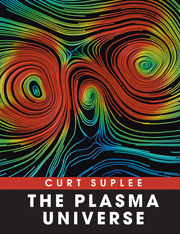Book contents
- Frontmatter
- Contents
- List of Figures
- Preface
- Chapter 1 The Fourth State of Matter
- Chapter 2 The Music and Dance of Plasmas
- Chapter 3 The Sun–Earth Connection
- Chapter 4 Bringing the Sun to Earth: The Story of Controlled Thermonuclear Fusion
- Chapter 5 The Cosmic Plasma Theater: Galaxies, Stars, and Accretion Discs
- Chapter 6 Putting Plasmas to Work
- Index
Chapter 5 - The Cosmic Plasma Theater: Galaxies, Stars, and Accretion Discs
- Frontmatter
- Contents
- List of Figures
- Preface
- Chapter 1 The Fourth State of Matter
- Chapter 2 The Music and Dance of Plasmas
- Chapter 3 The Sun–Earth Connection
- Chapter 4 Bringing the Sun to Earth: The Story of Controlled Thermonuclear Fusion
- Chapter 5 The Cosmic Plasma Theater: Galaxies, Stars, and Accretion Discs
- Chapter 6 Putting Plasmas to Work
- Index
Summary
IF THERE WERE A Guinness Book of Cosmic Records, listing the most astonishing, prominent, perplexing or destructive astrophysical events in the known universe, plasmas would appear, directly or indirectly, in nearly every entry.
That shouldn't really be surprising. According to the Big Bang theory, the cosmos erupted into existence about 13.7 billion years ago and spent most of its first 300,000 years as unalloyed expanding plasma until it cooled sufficiently for the first neutral atoms to form.
And even today, intact atoms make up no more than a tiny fraction of the observable universe. As a result, the effort to understand a broad spectrum of phenomena – from the way stars and planets coalesce out of plasma discs, to the evolution of galaxies, to the magnetic maelstroms around black holes and the firing of interstellar bullets we call “cosmic rays” – requires the perspective of plasma science.
What is surprising, however, is the remarkable ubiquity of magnetic fields in the universe, and the relationship of those fields to plasmas on size and intensity scales that range over dozens of orders of magnitude. There is no obvious reason that so many objects and aggregations of objects – including individual stars and planets, the interstellar medium, whole galaxies, and even the vast evacuated spans between galaxies – should have associated long-lived magnetic fields. But they do, and the dynamics of these bodies are strongly affected by the interplay of plasmas and fields.
- Type
- Chapter
- Information
- The Plasma Universe , pp. 51 - 62Publisher: Cambridge University PressPrint publication year: 2009



